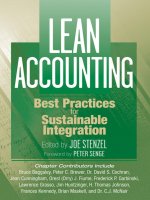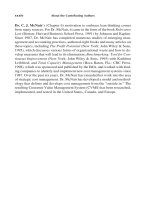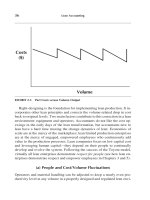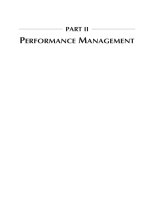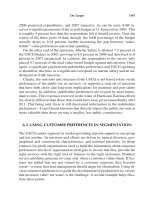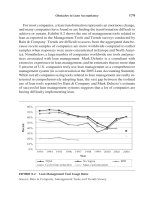Lean accounting pest practices for sustainable integration
Bạn đang xem bản rút gọn của tài liệu. Xem và tải ngay bản đầy đủ của tài liệu tại đây (12.64 MB, 344 trang )
ch00_4772.qxd
2/2/07
3:35 PM
Page i
LEAN ACCOUNTING
ch00_4772.qxd
2/2/07
3:35 PM
Page ii
ch00_4772.qxd
2/2/07
3:35 PM
Page iii
LEAN ACCOUNTING
BEST PRACTICES FOR
SUSTAINABLE INTEGRATION
Edited by
Joe Stenzel
WILEY
John Wiley & Sons, Inc.
ch00_4772.qxd
2/2/07
3:35 PM
Page iv
This book is printed on acid-free paper.
Copyright © 2007 by John Wiley & Sons, Inc. All rights reserved.
Published by John Wiley & Sons, Inc., Hoboken, New Jersey.
Published simultaneously in Canada.
No part of this publication may be reproduced, stored in a retrieval system, or transmitted
in any form or by any means, electronic, mechanical, photocopying, recording, scanning, or
otherwise, except as permitted under Section 107 or 108 of the 1976 United States
Copyright Act, without either the prior written permission of the Publisher, or authorization
through payment of the appropriate per-copy fee to the Copyright Clearance Center, Inc.,
222 Rosewood Drive, Danvers, MA 01923, 978-750-8400, fax 978-646-8600, or on the web
at www.copyright.com. Requests to the Publisher for permission should be addressed to the
Permissions Department, John Wiley & Sons, Inc., 111 River Street, Hoboken, NJ 07030,
201-748-6011, fax 201-748-6008, or online at />Limit of Liability/Disclaimer of Warranty: While the publisher and author have used their
best efforts in preparing this book, they make no representations or warranties with respect
to the accuracy or completeness of the contents of this book and specifically disclaim any
implied warranties of merchantability or fitness for a particular purpose. No warranty may
be created or extended by sales representatives or written sales materials. The advice and
strategies contained herein may not be suitable for your situation. You should consult with a
professional where appropriate. Neither the publisher nor author shall be liable for any loss
of profit or any other commercial damages, including but not limited to special, incidental,
consequential, or other damages.
For general information on our other products and services, or technical support, please
contact our Customer Care Department within the United States at 800-762-2974, outside
the United States at 317-572-3993 or fax 317-572-4002.
Wiley also publishes its books in a variety of electronic formats. Some content that appears
in print may not be available in electronic books.
For more information about Wiley products, visit our Web site at .
Library of Congress Cataloging-in-Publication Data:
Lean accounting : best practices for sustainable integration / edited by Joe Stenzel.
p. cm.
Includes index.
ISBN: 978-0-470-08728-2 (cloth)
1. Managerial accounting. 2. Organizational effectiveness. 3. Industrial efficiency.
I. Stenzel, Joseph, 1957–
HF5657.4.L42 2007
658.15′11—dc22
2006033471
Printed in the United States of America
10
9
8
7
6
5
4
3
2
1
ch00_4772.qxd
2/2/07
3:35 PM
Page v
CONTENTS
Foreword
Introduction
About the Contributing Authors
Part I
xi
xvii
xxix
Lean Essentials
1 LEAN DILEMMA: CHOOSE SYSTEM PRINCIPLES
OR MANAGEMENT ACCOUNTING CONTROLS—
NOT BOTH
3
H. Thomas Johnson
1.1 LEAN CURE: SYMPTOM VERSUS ROOT CAUSE
3
1.2 BUSINESS RESULTS: MECHANISM VERSUS LIFE SYSTEM
4
1.3 CONFUSION OF LEVELS: LEAN PRACTICES VERSUS
TOYOTA RESULTS
6
1.4 MANAGEMENT ACCOUNTING CONTROL SYSTEMS
BLOCK LEAN
7
1.5 LEAN ACCOUNTING ANSWERS THE WRONG QUESTION
9
1.6 ANSWERS TO THE RIGHT QUESTION—FROM SHEWHART
AND DEMING TO TOYOTA
10
1.7 MANAGEMENT ACCOUNTING CONTROLS OR SYSTEM
PRINCIPLES: PICK ONE, NOT BOTH
12
1.8 EPILOGUE: LEAN AND THE QUESTION OF SUSTAINABILITY
13
2 LIMITED PRODUCTION PRINCIPLES:
RIGHT-SIZING FOR EFFECTIVE LEAN
OPERATIONS AND COST MANAGEMENT
17
Jim Huntzinger
2.1 LIMITED PRODUCTION VERSUS ECONOMIES OF SCALE
18
2.2 LEAN AND RIGHT-SIZING
21
v
ch00_4772.qxd
2/2/07
3:35 PM
Page vi
vi
Contents
2.3 RIGHT-DESIGNING FOR FLOW
23
2.4 ONE-PIECE FLOW
25
2.5 BEGINNING THE JOURNEY: EXECUTING RIGHT-DESIGN
30
2.6 RIGHT-DESIGNING COST MANAGEMENT
33
2.7 ALL PARTS AT EQUAL COST
35
2.8 THE JOURNEY TO THE PROMISED LAND—PERFECTION
38
2.9 WHAT THE CFO NEEDS TO UNDERSTAND AND
COMMUNICATE DURING A LEAN TRANSFORMATION
39
3 LEAN STRATEGY AND ACCOUNTING:
THE ROLES OF THE CEO AND CFO
43
Orest Fiume
3.1 LEAN STRATEGY RESULTS
Part II
44
3.2 EASY TO AGREE WITH, HARD TO DO
45
3.3 WHAT DOES IT TAKE TO IMPLEMENT A LEAN STRATEGY?
46
3.4 THE ROLE OF THE CEO
47
3.5 LEAN AFFECTS ACCOUNTING
55
3.6 THE ROLE OF THE CFO
57
Performance Management
4 CREATING A NEW FRAMEWORK FOR
PERFORMANCE MEASUREMENT OF
LEAN SYSTEMS
69
Bruce Baggaley
4.1 THE PROBLEMS WITH TRADITIONAL PERFORMANCE
MEASURES
70
4.2 SOLUTION TO THE PROBLEMS
79
4.3 A STARTER SET OF LEAN PERFORMANCE MEASUREMENTS
86
4.4 SUGGESTIONS FOR IMPLEMENTATION
91
5 MOTIVATING EMPLOYEE PERFORMANCE IN
LEAN ENVIRONMENTS: RESPECT, EMPOWER,
SUPPORT
93
Frances Kennedy and Peter Brewer
5.1 ENTERPRISE EXCELLENCE AND PEOPLE
94
5.2 INNOVATION AND PEOPLE
96
ch00_4772.qxd
2/2/07
3:35 PM
Page vii
Contents
5.3 THE POWER OF RESPECT
Part III
vii
99
5.4 TWO VIEWS OF PERFORMANCE MOTIVATION
101
5.5 EMPOWERMENT AND PERCEPTIONS
103
5.6 MANAGEMENT CONTROL SYSTEMS AND LEAN
REGULATORY SYSTEMS
108
5.7 SUPPORTING LEAN PERFORMANCE MEASUREMENT
111
5.8 ACCOUNTING, LEAN PERFORMANCE, AND THE
EMPOWERED WORKFORCE
113
5.9 SUPPORTING THE TRANSFORMATION TO LEAN
116
Lean Accountancy
6 ON TARGET: CUSTOMER-DRIVEN LEAN
MANAGEMENT
121
Dr. C. J. McNair, CMA
6.1 THE ECONOMICS OF THE CUSTOMER
122
6.2 COST: A CUSTOMER’S PERSPECTIVE
123
6.3 CUSTOMER-DRIVEN LEAN MANAGEMENT: AN EXAMPLE
125
6.4 VALUE SEGMENTATION
136
6.5 USING CUSTOMER PREFERENCES IN SEGMENTATION
141
6.6 PUTTING THE CUSTOMER PERSPECTIVE INTO ACTION
146
6.7 BUILDING THE CUSTOMER IN: A SERVICE PERSPECTIVE
149
6.8 CLM: THE PATH FORWARD
150
7 VALUE STREAM COSTING: THE LEAN SOLUTION
TO STANDARD COSTING COMPLEXITY
AND WASTE
155
Brian Maskell and Nicholas Katko
7.1 THE PROBLEM WITH STANDARD COSTING
155
7.2 STANDARD COSTING IS ACTIVELY HARMFUL TO LEAN
157
7.3 VALUE STREAM COSTING
158
7.4 THE ADVANTAGES OF VALUE STREAM COSTING
163
7.5 CLOSING THE BOOKS
165
7.6 USING COST INFORMATION TO MANAGE THE
VALUE STREAM
166
7.7 BUSINESS DECISION MAKING USING VALUE STREAM
COSTING
168
ch00_4772.qxd
2/2/07
3:35 PM
Page viii
viii
Contents
7.8 VALUING INVENTORY
173
7.9 CHAPTER SUMMARY
176
8 OBSTACLES TO LEAN ACCOUNTANCY
177
Lawrence Grasso
8.1 UNDERSTANDING LEAN AS A MANAGEMENT SYSTEM
180
8.2 CULTURAL COMPATIBILITY WITH LEAN MANAGEMENT
181
8.3 OBSTACLES TO ACCOUNTANTS CHANGING TO
LEAN ACCOUNTING
185
8.4 MAJOR DEVELOPMENTS IN MANAGEMENT ACCOUNTING
194
8.5 OVERCOMING THE OBSTACLES
202
9 LEAN APPLICATION IN ACCOUNTING
ENVIRONMENTS
209
Jean Cunningham
9.1 GOAL AND FOCUS AREAS
210
9.2 KAIZEN EVENTS IN BRIEF
211
9.3 HOW TO GET STARTED AND NEVER END
213
9.4 WHAT TO EXPECT
234
10 SARBANES AND LEAN—ODD COMPANIONS
237
Fred Garbinski
10.1 OVERVIEW OF SARBANES
238
10.2 Q1: HOW WE GOT TO WHERE WE ARE
240
10.3 Q2: WHERE CAN WE GO FROM HERE?
243
10.4 Q3: ARE THERE COMMON DENOMINATORS BETWEEN
SARBANES AND LEAN THAT CAN BE USED AS A
SPRINGBOARD FOR THE FUTURE?
246
10.5 EXAMPLES OF INTEGRATING LEAN WITH SARBANES
258
10.6 WHAT’S NEEDED TO INTEGRATE LEAN WITH SARBANES
260
11 THE NEED FOR A SYSTEMS APPROACH TO
ENHANCE AND SUSTAIN LEAN
263
David S. Cochran, PhD
11.1 INTRODUCTION TO COLLECTIVE SYSTEM DESIGN
263
11.2 ACCOUNTING FOR LEAN COMMUNICATIONS
265
11.3 THE JOURNEY TO ACCOUNTING FOR LEAN
266
ch00_4772.qxd
2/2/07
3:35 PM
Page ix
Contents
ix
11.4 OBSTACLES TO SUSTAINABLE LEAN
271
11.5 THE ESSENTIALS OF SYSTEMS DESIGN WHEN
ACCOUNTING FOR LEAN
295
Glossary
299
Index
305
ch00_4772.qxd
2/2/07
3:35 PM
Page x
ch00_4772.qxd
2/2/07
3:35 PM
Page xi
FOREWORD
ENACTING, NOT IMPLEMENTING, LEAN MANAGEMENT
Managers always want to do something to improve how their organizations
function. The combined effects of global competition, the growth in business
books and magazines, and business consultancy has led to a never-ending series of fads to fix organizations. It often seems that these do more to confuse
than inform people, leading to one change program after another, what the people at Harley-Davidson dubbed many years ago, “AFP,” Another Fine Program
(often translated differently internally).
“Lean” is the fad of the day. For a top team to not have its version of a lean
management program is tantamount to managerial negligence. Yet, few of
these succeed in achieving their intended outcomes, just as few process redesign programs succeeded, and, before that, few TQM programs. In fact, Dr.
W. Edwards Deming, one of the pioneers of total quality, became so disgusted
with the fad fetishes of contemporary managers that he refused to use terms
like TQ, TQM, or Total Quality in the latter years of his life. For him they had
lost all meaning: “They mean whatever people want them to mean.”
The essays in this book represent the struggles of thoughtful and experienced
people to get their arms around why otherwise useful ideas and tools can contribute to ongoing improvement in a few organizations and become mindless
pabulum in so many others. Some of these contributors are good friends and
long-time colleagues. While in no way summarizing their insights, the following three core premises capture a bit of where they are coming from, I think.
Genuine Reflection Will Always Trump Simplistic Solutions
Dr. David Cochran talks about the failure to establish agreement on important functional requirements. Why would this occur? It should be evident to
xi
ch00_4772.qxd
xii
2/2/07
3:35 PM
Page xii
Foreword
everyone that such agreement is important, that forcing people to strive for
goals they care little about is not likely to compel commitment or success. Yet,
the agreement behind most lean initiatives is often token at best. It is not that
people do not see the need for improvement. It is more the case that they usually doubt that this latest “AFP” is likely to address the deeper issues that frustrate them.
Deming used to say, “No reflection, no learning.” But, what he meant by
this is lost on most managers trained in the instrumental problem solving
popular in modern management education. By these approaches, we first
“externalize” problems to a set of symptoms, usually measurable symptoms.
We then figure out clever ways to address those symptoms and then “implement” the respective solutions. But throughout, the process is limited by unquestioned assumptions, like, “We really do not need to understand how the
problem has arisen,” or “I am (or we are) separate from the problem.”
When pressed as to why they do not reflect more on how the problem has
arisen, the standard response is, “We just don’t have the time to do this.” But the
resulting superficial solutions rarely ever achieve lasting change—something
that people often readily acknowledge. So, they may not have the time to do
it, but they have plenty of time to “redo it,” often many times over.
Our experience has always been that there are deeper reasons than not
enough time for why we shy away from reflection. Paramount among these
is that people either feel unable or unwilling to confront the quality of conversation that is required. A conversation based on reflection on what exists that
we “do not see,” as Cochran says, may lead to seeing ways that we are part of
creating the problems, or that management systems in place focus people in
ways that reinforce the status quo, or that there are underlying issues of power
and personality about which people, in effect, have “taken an oath of secrecy.”
But failing to commit to more reflective conversation also masks our deepest aspirations and longings. It keeps people not only from talking about what
is, but what they truly desire. Such conversations are difficult. They do take
time. But they can end up saving much more time.
Systems Intelligence Will Always Trump Reductionistic Analysis
I am of the opinion that we are at the very beginnings of starting to wrestle
with the profound implications of a systems worldview, and that this awakening, which started in physics, biology, and other basic sciences but which really
ch00_4772.qxd
2/2/07
3:35 PM
Page xiii
Foreword
xiii
has its roots in timeless ways of understanding common to native people the
world over, will continue to unfold throughout this century.
That said, the time to start is now, and the benefits can be immediate as well
as for coming generations. Tom Johnson points out that Toyota, the most studied company in the world, still outperforms virtually all of its competitors,
many by a very long ways. How could this be? What are people missing?
I recall a story Professor Johnson used to tell about a colleague at Toyota’s
Georgetown manufacturing facility. He had hosted literally hundreds of groups
of visitors who had come to study the famous “Toyota production system.”
According to him, the visitors would often say, “Oh, you have a Kan-Ban system, so do we.” Or, “You have quality circles, so do we.” Or, “You have
process and value stream maps, so do we.” Professor Johnson added, “They
all see the pieces. What they do not see is the way they all go together.”
There is an old saying in the systems field, “If you divide a cow in two, you
do not get two small cows.” Systems have integrity. While they are composed
of elements, they are not defined by their elements but by how all these elements function as a whole. The easiest way to perceive a system is to look at
its functioning and then begin to imagine how the different elements must interact in order to produce this functioning. As one systems biology teacher put
it, “There is a world of difference between memorizing all the parts of a cell
and learning how the cell functions, how it processes nutrients, how it sheds
waste products, and how it maintains the integrity of the cell wall in the face
of continual onslaughts.”
These are the rudiments of systems inquiry but they are not as simple as
they appear—in part because of complexity and in part because we ourselves—
our mental models and our relationships with one another—are all among the
elements of the system. So, systems inquiry is, by its nature, reflective.
Moreover, in a living system, these elements are continually being recreated,
unlike in machine systems where the elements are fixed and simply decay over
time. So, how we continually recreate our relationships with one another, form
our interpretations of our work and reality, or shape our sense of shared purpose and specific goals—these ongoing activities are all part of the organization as a living system.
As soon as people start to contemplate this, their eyes cross and they can
easily see the task as impossibly daunting. But look around. We see countless
examples of very complex living human systems that function effectively.
Sporting teams, symphony orchestras, jazz bands, dance troupes, and even
ch00_4772.qxd
xiv
2/2/07
3:35 PM
Page xiv
Foreword
many families and working teams. It is not that creating healthy living systems
is impossibly complicated; it is the way we usually think about them that is impossibly complicated. Human beings have immense innate capacity for systems intelligence.1 Our task is to understand this intelligence and how it either
develops or stagnates. While rational and conceptual capacities are part of it,
it is also an active intelligence that is evoked by doing things that matter together. In short, we build systems intelligence by continually and reflectively
attempting to enact better ways of doing things. Systems intelligence cannot
be broken down into simple rules or tools. It can only be learned, or as the Chinese would say, “cultivated.”
Closely related to the folly of rules of systems intelligence is the naïve belief that the right measures will save the day. Measurement by its nature fragments. To measure someone’s temperature is to capture one tiny facet of how
one’s particular mind-body-heart system is functioning at that instant. This is the
difference between the physician as mechanic who looks at all the fragmented
indicators and the gifted medical practitioners who also looks at the person as
a whole. Managers need measures. All learners need ways to assess how they
are doing relative to their aims. Very often measures can contribute to this assessment. But it is foolish to confuse the metric with the assessment—like
confusing your temperature with your health.
Humility, openness and asking for help, from everyone, will always
trump arrogance and the naïve belief in the next greatest tools or leaders
“There are no answers—and even if there are, we do not have them.” This
could serve as a regular mantra for all those serious about the journey. At one
level, that we have not figured it all out is probably obvious to everyone. But
we do not act as if this is so. Leaders regularly communicate that the new strategy is the right strategy—that the new change program or this new set of tools
will solve our most intractable organizational issues—that the new boss will
transform a mistrusting, non-reflective, under-performing culture. We bow to
1
I am indebt to Esa Saarinen and Raimo Hämäläinen for the concept of systems intelligence:
Systems Intelligence Research Group at the Helsinki Technological University, www
.systemsintelligence.hut.fi. See, “Systems Intelligence: Connecting Engineering Thinking and
Human Sensitivity,” 2005, Hämäläinen and Saarinen (eds.). “Systems Intelligence—Discovering a Hidden Competence in Human Action and Organizational Life,” Helsinki University
of Technology, Systems Analysis Laboratory Research Reports, A88, October 2004.
ch00_4772.qxd
2/2/07
3:35 PM
Page xv
Foreword
xv
humility and then act as if we have all the answers. Perhaps, it is because we
do not know how to act otherwise.
Surely, regularly confessing ignorance and incompetence to your direct reports does not constitute a compelling management style. But confusing insight with “the answer,” or compelling vision with “the plan” undermines an
organization’s genuine learning spirit.
One of the corollaries of adopting a systems perspective is that there is no
complete answer, no definitive analysis. We have only working hypotheses,
and we are inevitably guided by vision and intuition. People in leadership positions grounded in these simple truths can build an enormous sense of common undertaking and shared responsibility. As one CEO once put it, upon his
retirement after a remarkable time of turnaround in a Fortune 50 business, “My
greatest learning was the power of my vulnerability. When I could, at certain
times, simply say, ‘I do not have a complete plan and there are things about
our business setting that I don’t fully understand, it turned out to be a tremendously effective invitation to others. People started to realize that, “Phil does not
have all the answers, and we all have to be part of figuring out what is needed.”
****
The simplest way I know to summarize these three premises is that We are
the organization as it operates today—what is visible, what is invisible, what
is working, and what is not working. The structures and systems that dominate,
both formal and informal structures, do so because we create them, day-byday, hour-by-hour, by the way we think and act. No one is holding a gun to our
heads. The rules we follow mostly take the form of habits we have acquired,
habits of thought and action. And, most of these habits, especially the deep
ones, are beyond our daily awareness. If the organization is stuck in counterproductive ways of doing things, it is because we are stuck, both individually
and collectively.
This is the theory of “enacted systems”—that the systems that govern how
families, organizations, industries, and societies work are created by their members. It is always tempting to find someone else to blame. Yes, there are external forces. Yes, there is history. These must be understood. But at some level it
is pointless to attribute our fate to these. Comforting perhaps. But pointless.
Enacting alternative systems is not easy. It requires tools, methods, and guiding ideas —like those you will find in the following pages. But, the right tools
used with the wrong spirit will amount to little more than symptomatic fixes,
short-term improvements but little longer-term change.
ch00_4772.qxd
xvi
2/2/07
3:35 PM
Page xvi
Foreword
Hopefully, appreciating these three premises will contribute to a learning
spirit that can make the insights and ideas that follow truly helpful in enacting
lean management rather than getting others to implement it. As this begins to
actually happen on a larger scale, “lean” can take its place, not as “the answer,”
but as one more step in the long journey toward truly healthy organizations—
organizations that, by their nature, contribute to economic, social and biological health and well being, for all.
Peter M. Senge
December 30, 2006
ch00_4772.qxd
2/2/07
3:35 PM
Page xvii
INTRODUCTION
Why are established lean enterprises so durably successful while so many attempts to become lean fail? The answer lies in the Anna Karenina principle,
an extension of Tolstoy’s observation: “Happy families are all alike; every unhappy family is unhappy in its own way.” In general, this means that a deficiency in any one of a number of factors critical to overall system function
dooms the new relationship. Human interactions with nature are replete with
examples of this principle. When an otherwise healthy species of plant or animal is introduced into a new ecosystem, the new species must harmonize with
many critical subsystems—longitude and latitude, rainfall, terrain, predators,
competitors, and sources of nutrition. More often than not, the introduction of
a new species fails because the new ecosystem cannot support the alien life
form, or the newly introduced species significantly disrupts the balanced subsystems of the finely tuned native ecosystem.
Unlike the balanced scorecard, activity-based costing and management,
quality management, or many of the other fine tools that can be integrated into
the overall enterprise ecosystem, lean is an ecosystem unto itself—an entirely
integrated set of subsystems (like a good marriage) that cannot be adopted in
a piecemeal fashion to manage a limited number of enterprise activities. An
enterprise might choose to become more lean, but its managers should not expect to become lean by borrowing here and there from an integrated system
where all practices are interdependent.
No single person can master the many details of the many interrelated lean
subsystems, so this book maintains an appropriate focus: to provide perspectives on the ways that established lean enterprises treat accounting and performance measurement practices as subsystems that support an integrated approach
to product and service delivery. Each chapter addresses important elements of
these two practices. The best way to introduce this book is to characterize its
authors and define the premises that guide their experience and writing, and
the best way to introduce the authors and the core theme of this book is with its
first premise.
xvii
ch00_4772.qxd
xviii
2/2/07
3:35 PM
Page xviii
Introduction
If the business of business is business, the business of the lean enterprise
is continuous, sustainable adaptation and well-being.
This first premise sounds like a strategy, and that is just the point. While
strategy has become a universal paradigm for organizational management,
lean is a universally sustainable strategy that leads all other evolving strategic choices. Lean enterprises universally seek to deliver value to the customer
by designing and endlessly perfecting value streams to meet customer needs
with continuous workflow processes from order to delivery that aggressively
identify and eliminate any form of waste that impedes work flow. Clearly, the
implementation of such a strategy does not fall within the purview of any single individual or functional discipline.
As learning leaders of the annual Lean Accounting Summit, this book’s
practitioner and academic authors have made a full-time commitment to lean
and to each other from many different accounting and performance measurement perspectives. Just as lean is a comprehensive enterprise strategy that depends on all employees working as informed decision makers, any thorough
treatment of lean management depends on a balanced team of informed experts
who share a common understanding of how each person contributes only one
or two perspectives to the whole picture.
This book presents the collected insights of some of the most experienced
lean accounting and performance measurement practitioners in America, but
a single question dominates the organization and presentation of their insights:
Why does a comprehensive understanding of the formula of lean principles
embedded in the Toyota Production System continue to elude and frustrate
otherwise intelligent people trying to implement it in their own enterprises?
The answer to this question comes in part from our second premise.
Learning lean is not a matter of personal initiative alone and cannot be acquired from textbooks, classrooms, conferences, or seminars; people learn lean
by working together as they actively practice lean principles in an enterprise
culture committed to lean from top to bottom, side to side.
In every chapter the authors emphasize the importance of building a culture
that levels the conventional information and authority hierarchies so typical
of traditional economy-of-scale organizations. Whether the topic is leadership,
process design, quality, performance measurement, employee motivation, or
accounting, people throughout enterprises choosing a transformation to lean
learn how to implement lean principles and reconfigure the workplace side by
side. Lean is a transformation of the enterprise, not a transition. Each chapter
ch00_4772.qxd
2/2/07
3:35 PM
Page xix
Introduction
xix
discusses concrete steps that employees at all levels can use to accomplish the
lean transformation together in the workplace.
This means that lean transformations cannot be sustained without first establishing the appropriate enterprise-wide culture, and an important reason
why Western enterprises so frequently fail at lean transformations lies in the
unwillingness of leadership to redefine their roles from financially biased
commanders-in-chief to operationally informed facilitators and resource
providers. Lean transformations depend on cultural transformations, and culture can only evolve when executive leadership understands the principles of
the new culture it wants to build. Once again, each chapter describes clear
steps for executive leaders and managers to use as they work with fellow employees to lay down the cultural foundations necessary to support sustainable
lean processes.
Why bother? The answer to this question comes from many sources, but the
third premise answers the question by capturing the essence of each source.
When followed as a comprehensive system, lean is simply a more mature
way for organizations to function in the current business environment.
Although it was conceived in the economic poverty of World War II Japan,
lean seems to have anticipated the newfound power that the Internet has placed
in the hands of the customer, and everyone is scrambling to capture customer
information for strategic advantage. Anchored in order-to-delivery process
structures where customer orders eliminate guesswork and waste by providing
the enterprise with full customer preference information, lean practitioners
continue to perfect cost-effective customer satisfaction with processes that actually learn—from the customers, suppliers, and the enterprise employees who
seek to perfect the processes that serve the customer. Wall Street increasingly
values intangibles, learning organizations, and human capital. Lean systems
by their very nature seek to optimize these three areas and represent a more
mature means of doing business than traditional economy-of-scale enterprises.
Consistent with this premise, new sciences like systems thinking, quantum
mechanics, and field theory have become increasingly more influential in the
management science literature over the last 20 years. Managers at all levels
and from all disciplines recognize the parallels between living organisms and
human organizations, and one of the most important parallels is the importance
of information sharing, connectivity, and relationships—cells to cells, cells to
organs, organs to organisms—and the natural ways that a decentralized relationship structure of these elements promotes maximum efficiency and survival
ch00_4772.qxd
xx
2/2/07
3:35 PM
Page xx
Introduction
advantages. This organic perspective on the lean enterprise is built into the
language of lean cultures where many “work cells” contribute to a “value
stream.” Traditional enterprises seem mechanical and inflexibly brittle by
comparison.
In Profit Beyond Measure (New York: Free Press, 2000), H. Thomas Johnson distinguishes between two enterprise cultures: the traditional, financially
driven, hierarchically structured management by results (MBR) culture and the
lean, operationally driven, distributive management by means (MBM) culture.
In MBR cultures, leadership focuses on quantitative results to achieve unlimited growth through command and control relationships (a tribal stage of organizational development). MBM culture leadership focuses on sustainable
growth by building current and future relationships with customers, with suppliers, with fellow employees throughout the enterprise in a system where all
these participants contribute to the ongoing perfection of customer delivery
processes (a democratic stage of organizational development). Lean is more
mature, but cultural change is the bottom line challenge. Each chapter addresses the challenges of evolving rigid traditional cultures and their organizational structures into adaptive lean cultures from the shop floor to the
executive suite.
Because lean is a transformation of enterprise maturity, and because so many
enterprises fail to make the total commitment to the steps that lead to lean maturity, this book presents the steps from the starting point of the traditional
enterprise—financial command and control systems designed to support
economies of scale. The primary components of traditional systems are strategy,
quality, cost, and performance management methodologies. The authors contrast traditional understandings of these methodologies in terms of lean principles so that managers can learn to create a more mature culture and guide the
enterprise-in-transformation to sustainable, integrated, interdependent work
processes that incorporate the customer, supply chain, and employee learning.
The book is organized in three parts that remain consistent with the sequence that people can best learn how lean principles support a radically new
enterprise structure and culture. Rather than jumping straight into accounting,
Part 1 addresses the lean principles, enterprise design, and leadership characteristics that form the foundation of a successful lean transformation. The order
of Parts 2 and 3 tacitly suggests another important characteristic of lean. Despite the obsession Western enterprises have with cost, cost is simply another
highly specialized form of performance management. Part 2 sets the stage for
an examination of lean accounting by focusing on performance measures in
ch00_4772.qxd
2/2/07
3:35 PM
Page xxi
Introduction
xxi
lean systems and how those systems motivate employees beyond the measures
and results incentives so characteristic of traditional reward and punishment
methods. From this platform, Part 3 provides a detailed examination of accounting relevance in the lean enterprise with a focus on the information that
managers in traditional enterprises need to facilitate the transformation.
A recurrent theme haunts Western enterprises in lean transformation and
serves as our fourth premise.
The comprehensive application of the lean principles embodied by the
Toyota Production System guides the cultural transformation necessary to
support the continuous, sustainable adaptation and well-being of the lean
enterprise.
To their detriment, financially driven Western managers have grown accustomed to displacing their focus on universal enterprise strategies for continuous, sustainable adaptation and well-being with the tactics and methodologies
designed to support strategy, as H. Thomas Johnson and Robert S. Kaplan describe in Relevance Lost (Boston: Harvard Business School Press, 1991). The
many individual tactics and methods for strategy development, quality, performance, and bookkeeping are bought and sold in piecemeal fashion like commodities. This form of enterprise management lacks cohesion, consistency, and
sustainability, and lean implementations eventually languish along with other
poorly integrated management solutions of the month.
After more than 60 years of unwavering practice in lean principles, the Toyota Production System is the unquestionable gold standard of lean practices
marked by continuous, sustainable adaptation and well-being that place Toyota at the top of a highly competitive marketplace. The authors make no excuses for learning from and writing about the longest-lived, most evolved lean
practitioner. While many other enterprises have learned to adopt the lean principles of the Toyota Production System, expect to hear an in-depth treatment
of the many different ways that Toyota uses its integrated system to maintain
its competitive advantage from chapter to chapter.
The final premise of this book is primarily editorial and serves as a challenge to the reader: Traditional levers of control have no place in the lean
enterprise.
Lean systems replace the notion of traditional control with system regulation,
but high-level managers have little or no incentive to relinquish the status they
enjoy as controllers—especially management accountants. Strategies for profit
and financial results breed mixed agendas for all managers. Conscientiously
applied lean principles provide an enterprise with a truly fiduciary culture where
ch00_4772.qxd
xxii
2/2/07
3:35 PM
Page xxii
Introduction
the fiduciary relationships among all employees are highlighted by good faith,
loyalty, and trust—not control.
CHAPTER 1 EXECUTIVE SUMMARY
“Lean Dilemma: Choose System Principles or Management Accounting
Controls—Not Both,” by H. Thomas Johnson
Written by one of the world’s most influential management historians and
committed lean researchers, Chapter 1 analyzes the current business climate
and discusses why it leads to so many lean initiative failures. Remaining consistent with all the book’s premises, this discussion looks at the root causes of
lean initiative failures rather than just the symptoms. Historical perspectives
help people see and understand legacy practices that do not work well in emerging, more mature systems. Lean is based on a long history of committed practice by an organization from the Orient, and this chapter characterizes and
contrasts the evolutionary sequence of two evolving business philosophies:
traditional, financially focused command and control structures and lean systems. The inability to recognize and understand these different philosophies
is the prime obstacle to successful lean transformation.
CHAPTER 2 EXECUTIVE SUMMARY
“Limited Production Principles: Right-Sizing for Effective Lean
Operations and Cost Management,” by Jim Huntzinger
Chapter 2 begins by analyzing the profound differences between traditional
economy-of-scale production methods and lean limited production methods
and their work process designs in terms of efficiency, waste, and adaptability.
This chapter then introduces core lean principles and terms that all employees in a lean transformation must understand before focusing on how lean organizations appropriately size each element of their work processes to eliminate
waste, facilitate continuous improvement, and optimize enterprise adaptability to changing business environments and customer preferences. This chapter concludes with a discussion of the implications of lean principles for
enterprise accounting systems.
ch00_4772.qxd
2/2/07
3:35 PM
Page xxiii
Introduction
xxiii
CHAPTER 3 EXECUTIVE SUMMARY
“Lean Strategy and Accounting: The Roles of the CEO and CFO,”
by Orest Fiume
Chapter 3 examines lean from leadership and strategy perspectives. The chapter begins with an overview of the critical relationship of strategy to the cultural characteristics essential for transforming a traditional organization into
a sustainable lean enterprise and names the two people who must know lean
principles well enough to make this happen—the CEO and the CFO. The chapter then discusses 12 critical aspects of the transformation process that the CEO
must lead if the company is to successfully implement a lean business strategy.
Finally, the chapter discusses the difficult task of the CFO in implementing a
lean strategy. The CFO must be concerned with the same focuses as the CEO
but also address other lean strategy implementation obstacles embedded in traditional financial accounting practices that undermine lean cultures—perhaps
the most common reason for the failure of sustainable lean transformations.
CHAPTER 4 EXECUTIVE SUMMARY
“Creating a New Framework for Performance Measurement of Lean
Systems,” by Bruce Baggaley
Chapter 4 takes a critical look at the book’s second major focus, lean performance measurement. Since lean strategies are universally based on continuous, sustainable adaptation and wellbeing, many lean performance metrics are
uniform across similar classes of lean enterprises whether oriented to product
or service delivery. This first performance measurement chapter focuses on
process measures, the first of two essential measurement categories for lean
enterprises. The chapter begins with an analysis of the ways that traditional measures undermine lean transformations because they focus more on the shareholder than the customer. The discussion then moves to the ways that managers
must structure lean performance measurement systems to enhance employee involvement and ownership to facilitate continuous learning and creative solutions
to problem solving rather than the color-within-the-line mandates of traditional
command and control measurement structures. Then, after describing the essential characteristics of lean performance measures and the way appropriate
ch00_4772.qxd
xxiv
2/2/07
3:35 PM
Page xxiv
Introduction
measures reflect core lean principles, this chapter concludes with the presentation of a starter set of lean measures.
CHAPTER 5 EXECUTIVE SUMMARY
“Motivating Employee Performance in Lean Environments: Respect,
Empower, Support,” by Frances Kennedy and Peter Brewer
Chapter 5 focuses on the second and most important of the two essential
measurement categories for lean enterprises—employee motivation. Measurements motivate human behavior, and lean measurement systems borrow from
a growing body of traditional research suggesting that people simply perform
better when intrinsically motivated by their work rather than when extrinsically motivated by money, job titles, and working hours alone. This chapter
describes the way that lean systems encourage employees to own and take pride
in their work—with an enterprise culture that proactively takes formal steps
to respect, empower, and support employee ownership of their work processes.
In three parts, this presentation details the ways that lean managers involve
employees in the creation and ongoing stewardship of the measures that monitor the quality and efficiency of the work they perform and the enterprise’s
processes themselves. This chapter discusses concrete methods that lean enterprises use to capture the most from their human assets—the collection of
talents and ingenuity employees possess and can apply to their work if given
the opportunity. Enterprises lose these competence assets when employees are
constrained by the extrinsic rewards of traditional performance management
systems; this chapter gives managers an alternative that embodies the best of
core lean principles.
CHAPTER 6 EXECUTIVE SUMMARY
“On Target: Customer-Driven Lean Management,”
by Dr. C. J. McNair, CMA
Chapter 6 launches the third and most extensive part of this book—lean
accounting—by discussing how lean accounting is a specialized extension of
performance management that addresses the driving force behind all lean en-


